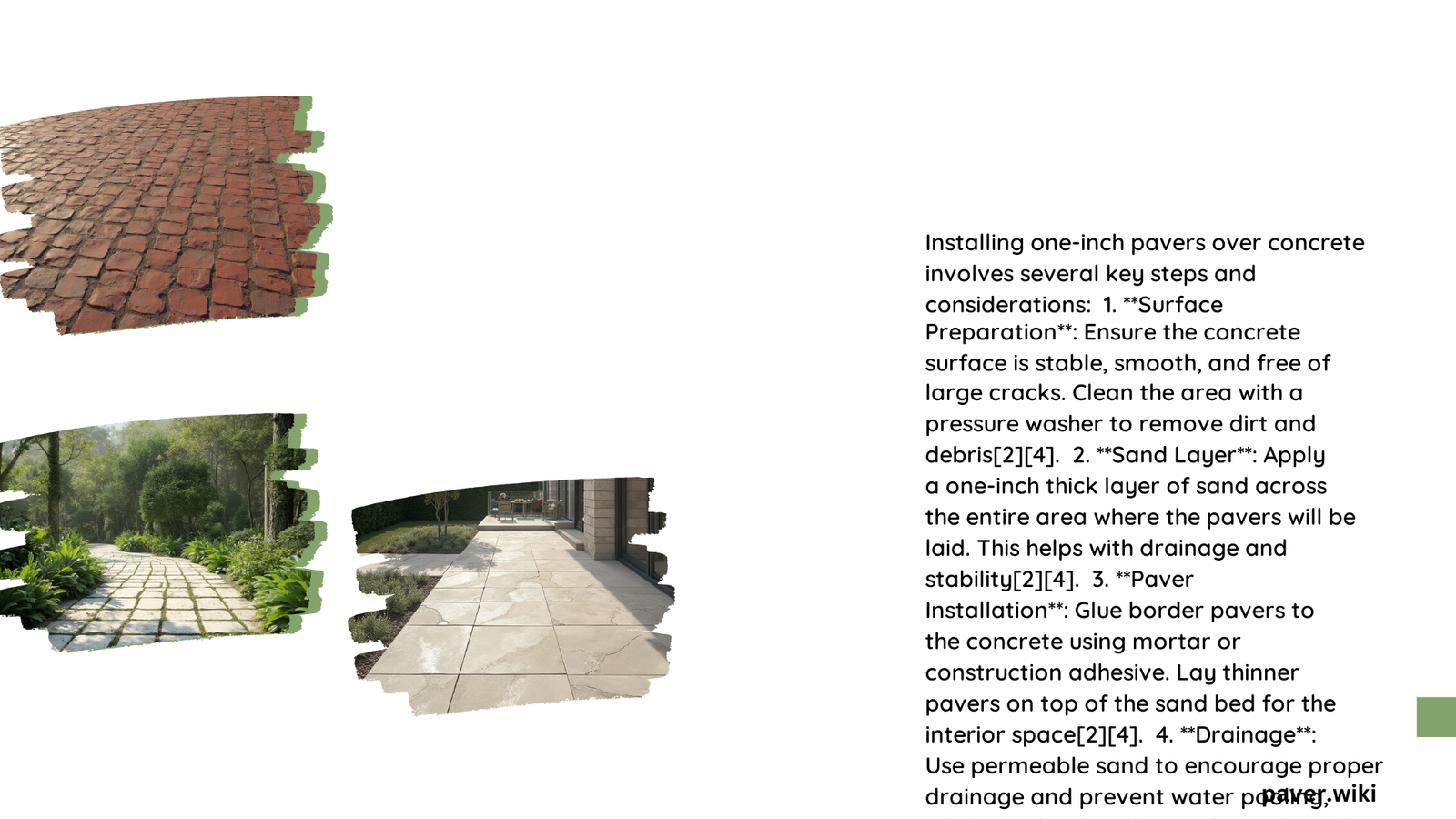One inch pavers over concrete offer a versatile and attractive solution for upgrading existing concrete surfaces. These thin pavers provide durability, aesthetic appeal, and cost-effectiveness when installed correctly. This comprehensive guide explores the specifications, benefits, installation techniques, and maintenance requirements for one inch pavers over concrete, helping homeowners and contractors make informed decisions about this popular hardscaping option.
What Are the Precise Specifications for One Inch Paver Thickness?
When installing one-inch thick interlocking concrete pavers over a concrete base, it’s crucial to adhere to specific specifications and techniques:
Materials
- Pavers:
- Must meet ASTM C 936 standards
- Average compressive strength: 8,000 psi (55 MPa)
- Minimum individual unit strength: 7,200 psi (50 MPa)
-
Average water absorption: 5% (maximum 7% for individual units)
-
Bedding Sand:
- Conforms to ASTM C 33 or CSA A23.1-FA1 gradations
-
1 inch deep, compacted for stability
-
Joint Sand:
- Meets ASTM C 144 or CSA-A179 grading requirements
- Particle size typically 2 mm and smaller
Joint Spacing
- Minimum spacing: 1/16 inch (1.6 mm)
- Ensures proper sand filling and stability
Base Preparation
- Excavation:
- Consider paver height, bedding sand depth, and base material thickness
-
Ensure base is well-compacted and level
-
Base Material:
- Use compacted aggregate base (e.g., Class II Road Base)
- Recommended thickness: 4 to 6 inches
-
Compact with vibrating plate compactor
-
Screeding the Bedding Sand:
- Achieve uniform 1-inch layer
- Use metal pipes and straight wood 2×4 for accurate leveling
What Are the Key Benefits of Using One Inch Pavers Over Concrete?

Durability
- Suitable for pedestrian and light vehicular traffic
- Average compressive strength: 8,000 psi (55 MPa)
- Ideal for most residential applications
Aesthetics
- Wide range of colors, patterns, and designs
- Enhances overall visual appeal
- Versatile layout options to match architectural styles
Cost-Effectiveness
- Easier to repair and replace individual units
- Reduces long-term maintenance costs
- Improves drainage, minimizing the need for extensive systems
What Are the Detailed Maintenance Requirements?
Cleaning Methods
- Regular sweeping to remove debris
- Mild detergent and water for thorough cleaning
- Avoid harsh chemicals and high-pressure washing
Sealing Recommendations
- Optional but recommended for protection and appearance enhancement
- Use sealer compatible with concrete pavers
- Apply after installation and cleaning
- Reapply every 2-5 years, depending on traffic and exposure
Frequency of Maintenance Activities
| Activity | Frequency |
|---|---|
| Regular Inspection | Periodically |
| Joint Sand Maintenance | Annually or after heavy rainfall |
| Cleaning | As needed, typically monthly |
| Sealing | Every 2-5 years |
What Are the Challenges During Installation and How to Overcome Them?
Drainage Issues
- Ensure base slope of at least 1/8 inch per foot
- Surface elevation of pavers: 1/8 to 1/4 inch above adjacent drainage inlets or channels
Substrate Conditions
- Subgrade and base material must be well-compacted and level
- Address base surface deficiencies before laying pavers
Recommended Solutions and Best Practices
- Compaction:
-
Use vibrating plate compactor for base and bedding sand
-
Edge Restraints:
-
Install around the perimeter to prevent shifting and ensure stability
-
Screeding:
-
Employ precise screeding method for uniform bedding sand layer
-
Proper Planning:
- Assess site conditions thoroughly before installation
-
Address any existing drainage or leveling issues
-
Quality Materials:
-
Use high-quality pavers and materials that meet industry standards
-
Professional Installation:
- Consider hiring experienced professionals for complex installations
By following these specifications, understanding the benefits, and addressing potential challenges, you can successfully install one inch pavers over concrete, creating a durable and attractive surface for your outdoor space.
References:
1. https://www.masonryandhardscapes.org/resource/pav-tec-009-13/
2. https://wausautile.com/media/product-files/AP-Thin-Set-Installation-SPEC-WT.pdf
3. https://www.rcpblock.com/installation-pavers.html
